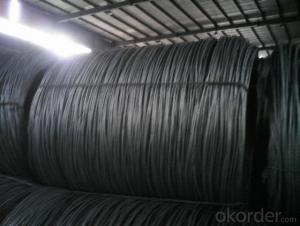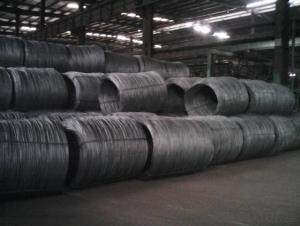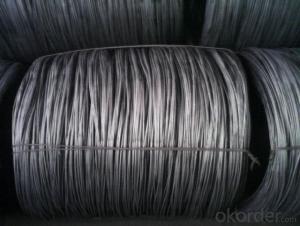Hot Rolled Steel Wire Rod SAE1008 for Constrction
- Loading Port:
- Shanghai
- Payment Terms:
- TT or LC
- Min Order Qty:
- 25 m.t.
- Supply Capability:
- 200000 m.t./month
OKorder Service Pledge
OKorder Financial Service
You Might Also Like
OKorder is offering Hot Rolled Steel Wire Rod SAE1008 for Constrction at great prices with worldwide shipping. Our supplier is a world-class manufacturer of steel, with our products utilized the world over. OKorder annually supplies products to African, South American and Asian markets. We provide quotations within 24 hours of receiving an inquiry and guarantee competitive prices.
Product Applications:
Hot Rolled Steel Wire Rod SAE1008 for Constrction are ideal for structural applications and are widely used in construction and manufacturing. Carbon steel wire rod is mainly used for reinforcement of reinforced concrete and welded structure or reprocessed (roberts , nail, etc.) materials, especially used to produce wire drawing, welding electrode, nails, spring, electronic, precise machinery parts and so on..
Product Advantages:
OKorder's Hot Rolled Steel Wire Rod SAE1008 for Constrction are durable, strong, and wide variety of sizes.
Main Product Features:
· Premium quality
· Prompt delivery & seaworthy packing (30 days after receiving deposit)
· Can be recycled and reused
· Mill test certification
· Professional Service
· Competitive pricing
Product Specifications:
Manufacture: Hot rolled
Grade: Q195 – 235
Certificates: ISO, SGS, BV, CIQ
Length: 6m – 12m, as per customer request
Packaging: Export packing, nude packing, bundled
Grade | Chemical Composition(%) | |||||
C | Mn | Si | S | P | B | |
SAE1006B | 0.03~O.07 | ≤0.32 | ≤0.30 | ≤0.045 | ≤0.040 | >0.0008 |
Mechanical properties | ||||||
Yield strength(N/mm2) | Tensile strength(N/mm2) | Elongation(%) | ||||
250-280 | 350-380 | ≥32 | ||||
Grade | Chemical Composition(%) | |||||
C | Mn | Si | S | P | B | |
SAE1008B | 0.10max | 0.3~O.50 | 0.15max | 0.050max | 0.040 max | 0.0008 min |
Mechanical properties | ||||||
Yield strength(N/mm2) | Tensile strength(N/mm2) | Elongation(%) | ||||
≥195 | 315-430 | ≥30 | ||||
Grade | Chemical Composition(%) | |||||
C | Mn | Si | S | P | B | |
Q195B | 0.06~O.12 | 0.25~O.50 | ≤0.30 | ≤0.050 | ≤0.045 | >0.0008 |
Mechanical properties | ||||||
Yield strength(N/mm2) | Tensile strength(N/mm2) | Elongation(%) | ||||
≥195 | 315-430 | ≥33 | ||||
Grade | Chemical Composition(%) | |||||
C | Mn | Si | S | P | B | |
Q235B | 0.12~O.2 | 0.3~O.701 | ≤0.30 | ≤0.045 | ≤0.045 | >0.0008 |
Mechanical properties | ||||||
Yield strength(N/mm2) | Tensile strength(N/mm2) | Elongation(%) | ||||
235 | 375-500 | ≥26 | ||||
FAQ:
Q1: Why buy Materials & Equipment from OKorder.com?
A1: All products offered byOKorder.com are carefully selected from China's most reliable manufacturing enterprises. Through its ISO certifications, OKorder.com adheres to the highest standards and a commitment to supply chain safety and customer satisfaction.
Q2: How do we guarantee the quality of our products?
A2: We have established an advanced quality management system which conducts strict quality tests at every step, from raw materials to the final product. At the same time, we provide extensive follow-up service assurances as required.
Q3: How soon can we receive the product after purchase?
A3: Within three days of placing an order, we will arrange production. The normal sizes with the normal grade can be produced within one month. The specific shipping date is dependent upon international and government factors, the delivery to international main port about 45-60days.
Images:
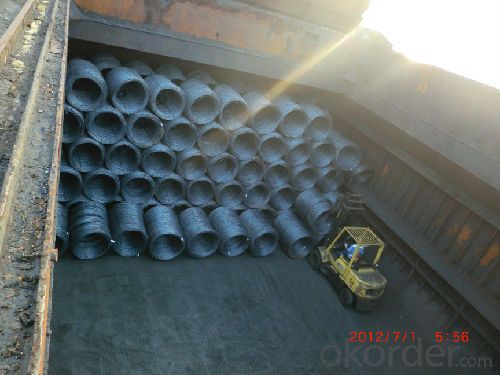
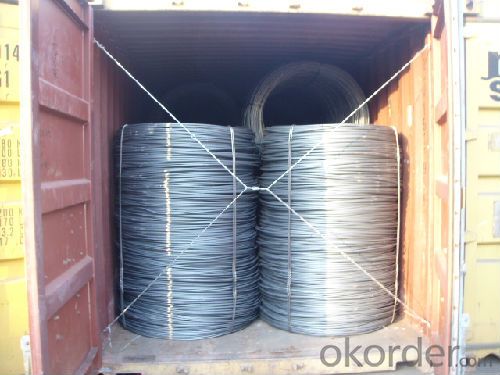
- Q:What are the different sizes and diameters available for steel wire rod?
- The sizes and diameters available for steel wire rod vary depending on the specific requirements and applications. Common sizes range from 5.5mm to 20mm in diameter, with some manufacturers offering larger sizes up to 32mm. The lengths typically range from 2,000mm to 6,000mm, but custom lengths can also be produced. It is important to note that each manufacturer may have its own range of sizes and diameters available.
- Q:How is steel wire rod used in the manufacturing of wire mesh conveyor belts?
- Steel wire rod is used in the manufacturing of wire mesh conveyor belts as it serves as the base material for creating the wire mesh. The steel wire rod is drawn and shaped into individual wires that are then woven together to form the mesh pattern of the conveyor belt. This process helps to provide strength, durability, and flexibility to the belt, making it suitable for various industrial applications such as conveying heavy loads or high-temperature materials.
- Q:What are the weight requirements for steel wire rod coils?
- The weight requirements for steel wire rod coils can vary depending on the specific application and industry standards. However, in general, the weight of steel wire rod coils typically ranges from a few hundred kilograms to several metric tons. The specific weight requirements are determined by factors such as the intended use of the wire rod, the type and grade of steel being used, and the transportation and handling capabilities of the facilities involved. It is important to consult the appropriate industry standards and specifications to ensure compliance with weight requirements for steel wire rod coils in a particular application.
- Q:How does the manufacturing process of steel wire rod impact its mechanical properties?
- The manufacturing process of steel wire rod can have a significant impact on its mechanical properties. Factors such as the type of steel used, the temperature and duration of the heating process, the rate of cooling, and the amount of deformation applied during rolling can all influence the final mechanical properties of the wire rod. For example, a higher heating temperature and slower cooling rate can result in a more uniform microstructure and improved ductility, while excessive deformation during rolling can lead to grain elongation and reduced strength. Therefore, careful control and optimization of the manufacturing process are essential to ensure desired mechanical properties in the steel wire rod.
- Q:What are the different manufacturing processes for steel wire rod?
- There are several manufacturing processes for steel wire rod, including hot rolling, cold drawing, and galvanizing. Hot rolling involves heating the steel billet and passing it through a series of rollers to reduce its diameter and increase its length. Cold drawing involves pulling the hot-rolled wire rod through a die to further reduce its diameter and improve its surface finish. Galvanizing is a process where the wire rod is coated with a layer of zinc to protect it from corrosion. These processes can be combined or used individually, depending on the desired properties and applications of the steel wire rod.
- Q:How is the ductility of steel wire rod measured?
- The ductility of steel wire rod is typically measured using a test called the tensile test, also known as the tension test. In this test, a sample of the steel wire rod is subjected to gradually increasing tensile forces until it fractures. Throughout the test, the elongation or deformation of the sample is measured, which provides an indication of its ductility. During the tensile test, the steel wire rod sample is clamped at both ends and a gradually increasing force is applied to one end. As the force is applied, the sample begins to elongate, and the amount of elongation is recorded. This elongation is usually measured as a percentage of the original length of the sample and is called the percentage elongation. In addition to measuring the elongation, the tensile test also measures the ultimate tensile strength of the steel wire rod. This is the maximum stress that the sample can withstand before it fractures. The ultimate tensile strength is an important parameter in assessing the overall mechanical properties of the steel wire rod. By conducting tensile tests on multiple samples of the steel wire rod, the average ductility of the material can be determined. This information is crucial in various industries that utilize steel wire rod, such as construction, automotive, and manufacturing, as it helps engineers and designers understand how the material will behave under different loads and conditions.
- Q:How are steel wire rods used in the production of piano wire?
- Steel wire rods are used in the production of piano wire by being drawn through a series of dies to gradually reduce their diameter. This process, known as wire drawing, results in a long, thin, and high-tensile strength wire that is then coiled, hardened, and tempered to create the strong and resilient piano wire used in piano strings.
- Q:What are the main factors influencing steel wire rod pricing?
- The main factors influencing steel wire rod pricing include the cost of raw materials such as iron ore and scrap metal, energy prices, production costs, market demand and supply dynamics, global economic conditions, and government policies and regulations. Additionally, factors like transportation costs, currency exchange rates, and the competitive landscape can also impact steel wire rod pricing.
- Q:How is steel wire rod used in the manufacturing of medical devices?
- Steel wire rod is used in the manufacturing of medical devices in various ways. It can be shaped and formed into different components such as springs, coils, and meshes, which are essential for the functionality and structural integrity of medical devices. Additionally, steel wire rod is often used as a reinforcement material in surgical instruments, catheters, and orthopedic implants, providing strength and durability to these devices.
- Q:How is steel wire rod used in the production of wire for wire rope slings?
- The production of wire rope slings relies heavily on steel wire rod. This raw material is used to manufacture the wire ropes that are essential components of wire rope slings. To transform the wire rod into wire ropes, a series of manufacturing steps are undertaken. These steps include drawing, stranding, and closing the wire ropes. Initially, the wire rod is drawn through a die to decrease its diameter and increase its length. This process enhances the wire's strength and flexibility. Once the drawing process is complete, the wire rod is then stranded by twisting multiple wires together to form a strand. Multiple strands are further twisted to create the wire rope. This stranding process adds strength and durability to the wire rope, making it suitable for demanding applications. To complete the manufacturing process, the wire rope is closed by utilizing specialized machinery to form a loop or an eye on one or both ends. This closure ensures a secure attachment of the wire rope to equipment or structures, allowing for safe lifting and handling. In summary, steel wire rod plays a crucial role in the production of wire for wire rope slings. Through various manufacturing processes, the wire rod is transformed into wire ropes that possess exceptional strength, flexibility, and durability. These wire ropes are then utilized in the construction of wire rope slings, which are extensively used in lifting and rigging operations across diverse industries.
1. Manufacturer Overview |
|
|---|---|
| Location | |
| Year Established | |
| Annual Output Value | |
| Main Markets | |
| Company Certifications | |
2. Manufacturer Certificates |
|
|---|---|
| a) Certification Name | |
| Range | |
| Reference | |
| Validity Period | |
3. Manufacturer Capability |
|
|---|---|
| a)Trade Capacity | |
| Nearest Port | |
| Export Percentage | |
| No.of Employees in Trade Department | |
| Language Spoken: | |
| b)Factory Information | |
| Factory Size: | |
| No. of Production Lines | |
| Contract Manufacturing | |
| Product Price Range | |
Send your message to us
Hot Rolled Steel Wire Rod SAE1008 for Constrction
- Loading Port:
- Shanghai
- Payment Terms:
- TT or LC
- Min Order Qty:
- 25 m.t.
- Supply Capability:
- 200000 m.t./month
OKorder Service Pledge
OKorder Financial Service
Similar products
New products
Hot products
Related keywords

